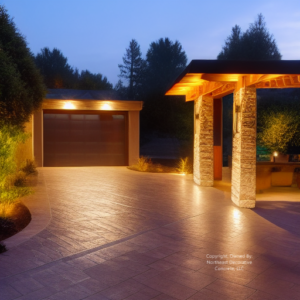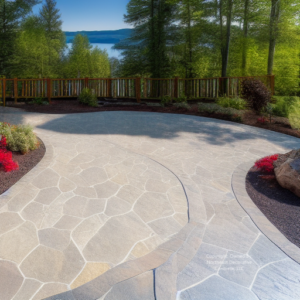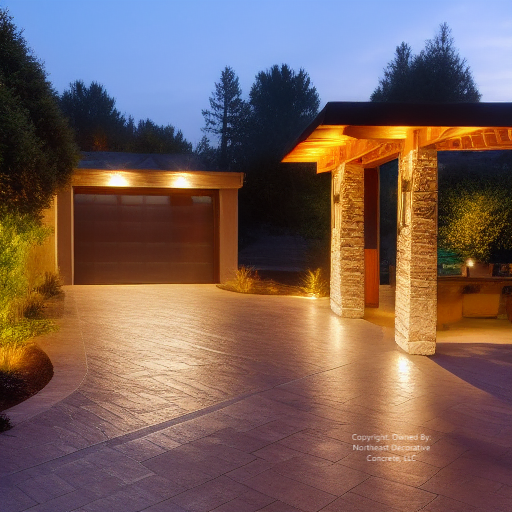
Wondering if you can seal concrete twice? Find out more about the process of sealing concrete and the benefits of double sealing in this comprehensive guide.
Can You Seal Concrete Twice?
The short answer is yes, you can seal concrete twice. In fact, it’s recommended to apply two coats of sealant to concrete surfaces. Double sealing provides extra protection and ensures that the sealant is evenly applied. Additionally, double sealing also helps to ensure that the sealant lasts longer and provides better protection. Make sure the weather is going to be dry for at least 24hrs before and after you seal your concrete. The best time of the day to seal is around noon time because the temperature will be warm enough to lay the sealant according to manufacturers’ suggestions, which is between 50°F and 85°F.
Decorative concrete is an incredibly versatile building material, but it’s also prone to wear and tear. To keep concrete looking good and protected from the elements, it’s important to coat it. But can you waterproof concrete twice? Read on to find out more about the process of coating concrete and the benefits of double sealants.
What is Concrete Sealing?
Concrete sealing is the process of applying a protective coating to concrete surfaces to protect them from water, oil, and other contaminants. Waterproofing also helps to restore the natural color of the decorative concrete and enhance the overall appearance. The sealant acts as a barrier between the concrete and the elements, preventing water from seeping into the concrete and causing damage.
Benefits of Sealing Concrete
- Sealant coatings for concrete offers a range of benefits, including:
- Improves the look and feel of the concrete surface
- Extends the life of the concrete
- Makes the surface easier to clean and maintain
- Protects the concrete from water and other contaminants
- Enhances the durability and longevity of the surface
- Prevents mold and mildew growth

What Types of Concrete Sealers are There?
1. Acrylic Sealer: This comes in a water-based or solvent based form of sealer that is often used for both interior and exterior surfaces. It provides a clear wet look, glossy finish and is often used to protect surfaces from staining and weathering.
2. Epoxy Sealer: This sealer is often used to protect surfaces from chemicals, abrasion, and extreme temperatures. It is usually applied in two coats, and it provides a glossy, durable finish.
3. Penetrating Sealer: This sealer penetrates the concrete, forming a protective barrier that prevents water and other liquids from entering the concrete. It does not leave a glossy finish, but it is often used to protect the concrete from staining and weathering.
4. Polyurethane Sealer: This sealer is often used to provide a durable, glossy finish. It is usually applied in two coats, and it is perfect for protecting surfaces from abrasion and extreme temperatures.
5. Polyaspartic Sealer: This sealer is often used to protect surfaces from freezing temperatures. It provides a glossy finish and is usually applied in two coats.
How to Seal Twice
The process for double coating concrete is relatively straightforward. First, make sure the surface is clean and dry before applying the first coat of sealant. Allow the first coat to dry completely, waiting for 24hrs before applying the second coat. Make sure to use a brush or roller to evenly spread the sealant, and allow the second coat to dry completely before using the surface.
How to Seal the Proper Way
1. Clean the Surface: Begin by cleaning the surface of the concrete with a broom, leaf blower, or pressure washer. Remove any dirt, dust, and debris.
2. Repair Cracks: Use a concrete patching compound to repair any cracks or holes in the concrete. Allow the patching compound to dry according to the manufacturer’s directions.
3. Etch the Surface: Use a concrete etching solution to etch the surface of the concrete. This will help the sealer bond with the concrete.
4. Apply the Sealer: Use a roller to apply the sealer to the concrete. Start at one corner of the surface and work your way across the entire area. Allow the sealer to dry fully according to the manufacturer’s directions.
5. Check for Adequate Coverage: Once the sealer has dried, check for adequate coverage. If necessary, apply a second coat of sealer to any areas that appear to have been missed.
Materials Needed To Seal New Concrete
If you’re looking to take on a waterproofing project, you’ll need to make sure you have the right materials. From adhesives and sealants to tapes and caulks, there are plenty of options out there to get the job done.
Make sure you read the instructions carefully to ensure you’re getting the best results. After the sealant has been applied, you’ll need to give it time to cure and set. Once this is done, you can enjoy the finished product!
- Concrete Sealant
- Slip Resistance Additive
- Sealer Applicator
- Broom
- Pressure Washer
- Masking Tape
- Paint Roller
- Paintbrush
- Goggles
- Rubber Gloves
- Water Hose
- Poly Sheet or Tarp
- Safety Cones, Safety Tape, or Traffic Signs

How To Properly Mix The Slip Resistance Additive With The Sealant
1. Thoroughly stir the sealant with a mixing paddle to ensure the ingredients are fully blended.
2. Measure the desired amount of slip-resistant additive and pour it slowly into the sealant.
3. Continue stirring until the slip-resistant additive is fully blended into the sealant.
4. Test a small area of the surface to be coated to ensure the desired result is achieved.
5. If necessary, adjust the proportions of the sealant and slip-resistant additive until the desired result is achieved.
6. Apply the mixture to the surface according to the manufacturer’s instructions.
Tips and Tricks
- Ensure the surface is clean and free of any dirt, debris, or loose particles.
- Apply a concrete sealer that is designed for the surface, such as a water-repellent sealer for exterior concrete or a penetrating sealer for interior concrete.
- Make sure to follow the manufacturer’s instructions for application.
- Apply a second coat of sealer for extra protection and durability.
- Let the sealer dry completely before allowing foot traffic or the application of any other products.
- Apply a concrete sealer regularly to maintain the condition of the concrete.
Should You Stop Sealing Concrete?
It is not necessary to stop waterproofing concrete as it helps protect it from the elements, such as water, dirt, and chemicals. Coating concrete also helps maintain the color and texture of the concrete, as well as helps to prevent cracking and other damage. However, if the concrete is already sealed, it may not need to be coated again, as the sealant may still be effective. If you have any questions, it is best to consult a professional concrete contractor to determine if sealing is still necessary.
FAQs
Q. What kind of Sealant Should I Use on Concrete?
A. The type of sealant you use will depend on the type of concrete you’re waterproofing and the conditions it will be exposed to. Generally, a penetrating sealer is recommended for exterior surfaces and a topical sealer is best for interior surfaces.
Q. How Often Should I Seal My Concrete?
A. The frequency of concrete sealant will depend on the type of sealant used and the conditions the concrete is exposed to. Generally, it’s recommended to reseal concrete every 3-5 years.
Q. Best Time To Apply Concrete Sealer?
A. The best time to apply concrete sealer is when the concrete is completely dry and the outdoor temperature is between 50°F and 85°F.
Q. When Can I Apply a Second Coat of Concrete Sealer?
A. The best practice is to wait at least 24 hours before applying a second coat of concrete sealer.
Q. How Many Times Can you Seal Your Concrete?
A. Porous concrete can be sealed as often as necessary, depending on the condition of the concrete. Generally, it is recommended that new concrete be Waterproofed every 3 to 5 years.
Q. Can You Put Sealer on Top of the Sealer?
A. Yes, you can put sealer on top of sealer, however, it is important to make sure the sealers are compatible with each other and that you are following the manufacturer’s instructions for application. You might have to remove the old sealer in certain circumstances.
Waterproofing concrete is an important part of maintaining and protecting the surface. Double coating is recommended to provide extra protection and to ensure that the sealant is evenly applied. When double waterproofing unsealed concrete, make sure to allow each coat of sealant to dry completely before applying the next coat. With proper coating, you can extend the life of your new concrete patio, driveway surfaces and keep them looking good for years to come. Call your local concrete contractor if you need help.
Our Locations:
Nashua, NH
North Hampton, NH
Concord, NH

